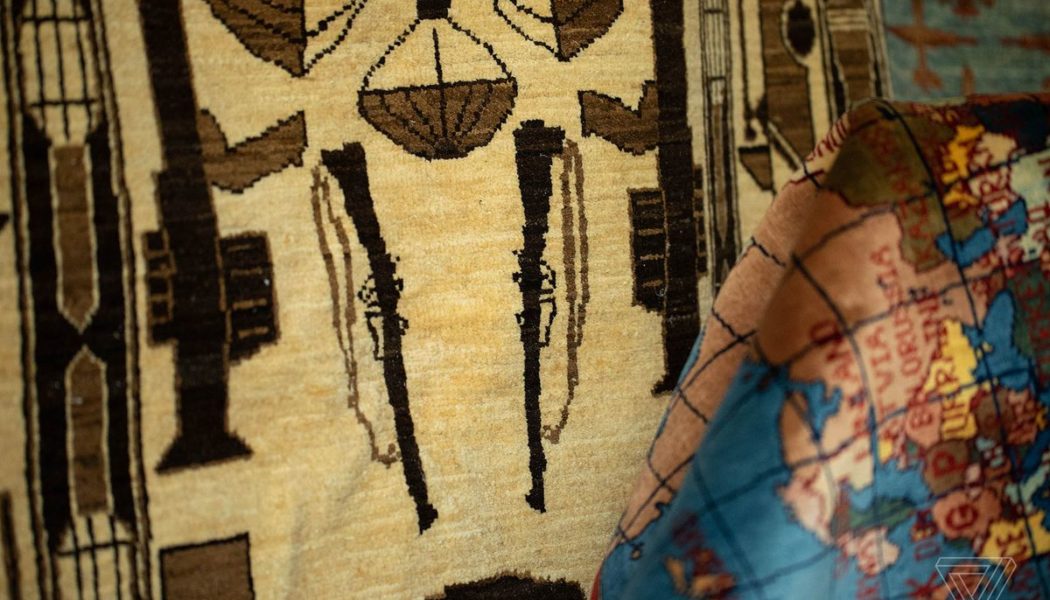Aaron Davies remembers being blown away by the colors. Instead of the muted tones and abstract motifs of traditional Persian carpets, the rug in front of him depicted a map of Afghanistan surrounded by guns and tanks, woven with fluorescent pink, green, and blue threads. Known as a “war rug,” the textile made by Afghan weavers had traveled all the way from Peshawar, Pakistan, to his home in the United Kingdom in a battered cardboard box.
“I just thought they were amazingly interesting,” says Davies, “It’s just such a bizarre concept to put on a rug.”
Peshawar, near Pakistan’s border with Afghanistan, is home to a large Afghan refugee community and is a center of the country’s rug trade. Davies had purchased the rug online from a seller going by Imran Khan, who later told Davies that his store had been removed from eBay and he was having trouble moving his rugs. Would Davies be interested in buying some war rugs in bulk and selling them on? Taking a gamble, Davies put in an order for 30 rugs.
Three years later, Davies had become an accidental war rug dealer, a side job he does in addition to working full time as a carpenter on TV and movie sets. He runs Silver Tongue War Rugs And Exotic Supplies from his home in Surrey, England. Davies buys around 10 or 15 rugs a month, selling them for between $130 and $330 through listings on Etsy, eBay, Instagram, Facebook, and the company’s website. Davies donates 5 percent of all sales to Afghan Aid.
:no_upscale()/cdn.vox-cdn.com/uploads/chorus_asset/file/23440638/akrales_220428_5110_0384.jpg)
The business was small but growing. Then, in April 2021, the problems started.
Davies started receiving notifications that some of his listings were being removed from sales platforms due to copyright complaints. That these Afghan rugs could be copyrighted seemed impossible to Davies, so over the next few months, he dutifully appealed each of the removals. Each time, he waited the 10 days necessary by law to see if a court order was filed, then re-listed his rugs in the online shops.
But each time, the listing would be reported and removed again.
Soon, more than 40 rugs had piled up in Davies’ house, and his Instagram account and Wix website had been taken offline because of the constant legal complaints.
By then, a pattern had emerged. All the rugs being reported showed images of drones. And one person was behind all the complaints: someone named Kevin Sudeith, based in Brooklyn, New York, who was claiming to own the copyright to a swath of Afghan rugs.
“I was blown away that an American guy would have a copyright on an Afghan rug,” Davies says.
These rugs were woven in Afghanistan and Pakistan. So how, Davies wondered, could someone in New York own the copyright to an indigenous art form?
:no_upscale()/cdn.vox-cdn.com/uploads/chorus_asset/file/23440625/akrales_220428_5110_0039.jpg)
Carpet-weaving in central and western Asia stretches back at least two and a half millennia. The oldest known rug on earth was found frozen in ice in the grave of a Scythian prince in modern-day Siberia. It depicts griffins, deer, lotus flowers, and men on horseback and dates from around 400 BC.
Over the next millennia, trade brought these intricate rugs to the West, sparking a fascination that continues to this day. Medieval nobles in Europe used Turkish rugs as tablecloths. Islamic carpets appear so often in Renaissance paintings that Western art historians named the carpet styles after the artists who painted them. In the 19th century, American magnates like Hearst and Rockefeller, keen to emulate British aristocracy, amassed their own collections of Oriental rugs.
There has always been a complex interplay between Western buyers and the weavers and sellers in Western Asia. Afghan war rugs are a tiny part of the tapestry but one of its most enigmatic elements.
“Do they come from the initiative of the weavers themselves, or of middlemen on the lookout for new markets?” asked anthropologist Brian Spooner, writing about war rugs for an exhibition in 2011.
First appearing after the Soviet invasion of 1979, early war rugs depict Russian airplanes, tanks, and guns in geometric, repetitive patterns. Some show maps of Afghanistan with phrases spelled out in capitals like: “DEATH TO RUSSIA” and specific weapons labeled with their Afghan nicknames.
:no_upscale()/cdn.vox-cdn.com/uploads/chorus_asset/file/23440633/akrales_220428_5110_0259.jpg)
Noor Khan, the owner of Noor and Sons, a rug shop in Berkeley, California, remembers seeing these early war rugs at markets on the border with Pakistan and Afghanistan in the 1990s.
Nomads would travel from Afghanistan to sell one or two rugs made by their family, often carrying them around the dusty market draped over their shoulders. These nomadic peoples have been weaving rugs for thousands of years, Khan says, depicting what they saw around them. When war came to Afghanistan, they wove new stories.
“They started seeing helicopters flying over them,” Khan says. “They saw their children being bombed. And they would weave those as a description of their lifestyle. Not knowing these [rugs] are going to the Western part of the world. They were just weaving it as something to leave behind.”
Khan was born in Afghanistan into the Ersari tribe, part of the Turkmens, an ethnic group renowned for rug-making. During the Soviet invasion, Khan fled Afghanistan with his seven siblings, settling in a large Afghan refugee community in Pakistan. There, his father built a rug business, which Khan joined as a young man. In the early days, he sold war rugs in his shop in Islamabad.
The main buyers were diplomats, journalists, and members of NGOs from the West. The rugs were often small enough to fit in a suitcase, made on portable looms. When rug sellers realized the combat designs were popular with Westerners, they commissioned weavers to make more, even providing designs on graph paper for the weavers to copy, says Khan.
While the first war rugs sprung from the imaginations of their creators, the situation in subsequent years has become more complicated. Rug-making in Afghanistan has traditionally been women’s work, but in more desperate economic times, men — and even children — have had to work in the industry. In 1989, two Western travelers saw whole families involved in making war rugs in a refugee camp in Pakistan. A 2014 survey found that Afghan children as young as six were working in the wider carpet industry.
By the time the war rugs reach the West, their origins are often surrounded by mystery. When Canadian curator Max Allen wanted to put on an exhibit of Afghan war rugs in 2008, he had to buy most of them himself on eBay.
“Here’s a show where I can’t tell you where the rugs are from. I can’t tell you who made them. I can’t tell you where, I can’t tell you when and I can’t tell you why,” Allen told the Toronto Star.
As Afghanistan’s people continued to weather decades of civil war and, later, American invasion, the images on the rugs changed. After 9/11, a rash of rugs appeared that showed two planes crashing into the Twin Towers, sometimes with a dove of peace copied from an American propaganda leaflet.
Some rugs of this period appear supportive of the American invasion (celebrating “The Afghanitan Freinship With Amrica”), while others are more critical. Khan suggests these more overtly political rugs likely reflect the opinions of the manufacturers rather than the weavers themselves, who might just be copying a design.
In more recent years, they’ve shown the tanks, bombs, and guns of modern warfare.
Then, in 2014, a new kind of rug appeared, depicting the newest weapons of war: drones.
:no_upscale()/cdn.vox-cdn.com/uploads/chorus_asset/file/23440639/akrales_220428_5110_0429.jpg)
Kevin Sudeith first saw a war rug in the house of an Italian collector in 1996. He described being awed by the piece, which had a traditional border but a field “full of tanks and helicopters, grenades and rifle,” in an interview with The World. Sudeith, an artist himself who makes rock carvings, was struck by the interplay of traditional design with modern imagery.
He began collecting rugs and then selling them, first at flea markets in New York City and then from his website, WarRug.com.
After 9/11, Sudeith feared his business would collapse. ‘’I don’t think New Yorkers are ready for them yet,’’ he told The New York Times in 2003.
Instead, there was a surge of interest. Within a few years, prices for the rugs had quadrupled, Sudieth told a journalist in 2019. Sudeith is currently listing rugs for sale between $300 and $12,000.
In the years since he began collecting, Sudeith has risen to prominence as an expert on war rugs, appearing in multiple stories in The New York Times, Forbes, and on NPR. He is quoted by curators in exhibition catalogs and in academic papers.
When drone imagery started to appear in late 2014, Sudeith spoke to numerous news outlets about the new motif. His last order of rugs contained three with “depictions of American drones in a kind of geometric design,” he told NPR early the next year. He told another outlet that he had never met the weavers of the rugs but hoped to one day.
“I want to know what motivates them to combine their contemporary life with their ancient patterns and traditions,” he told The World.
These pilotless weapons, first used in Afghanistan by the US military in 2001, had become ubiquitous as the war floundered on. By the time the US withdrew from Afghanistan last year, at least 4,000 Afghans had died in drone strikes, including an estimated 73 children.
:no_upscale()/cdn.vox-cdn.com/uploads/chorus_asset/file/23440634/akrales_220428_5110_0311.jpg)
The appearance of drone rugs prompted a flurry of media attention, with articles appearing in The Atlantic, The Guardian, and Fast Company.
But now, Sudeith says these designs did not emerge naturally into the market: instead, he maintains that he was involved in designing them. Sudeith says he created the drone rug designs in collaboration with a group of weavers in 2014. He filed a copyright for five works, all featuring drones, in December 2018.
“These drone rugs have been the most important and significant artworks I’ve worked on,” Sudeith says. “They’re WarRug.com designs. I made them. I copyrighted them. I own the copyrights. Full stop.”
Sudeith says he had no idea the drone rugs would go viral. “This artwork has really struck a chord with people around the world in a way that’s really interesting, and I feel pleased to be part of the public discourse,” he says. “It was like a worldwide phenomenon, and it’s my artwork. I just want to protect it.”
This is why Sudeith says he’s been filing takedowns so aggressively. Sudeith maintains that the drone rugs Davies listed for sale in 2021 violated his copyright. Davies’ dealer in Pakistan, Imran Khan, says Sudeith’s infringement claims are what got his listings removed years ago, too.
After Davies continued to re-list his rugs — which, at one point, included a modified version of the drone design featuring big block letters spelling out “FUCK KEVIN” — Sudieth escalated the situation. In September 2021, he filed a lawsuit against Davies in federal court in New York, alleging repeated copyright infringement and suing Silvertongue for damages.
While Sudeith and Davies battle over distribution, the Afghan creators remain outside of the equation. Lack of education and poverty puts the original makers in a uniquely vulnerable situation when it comes to copyright, says Zamira Saidi, a Fulbright Scholar specializing in intellectual property law. Saidi was born and raised in Afghanistan. Basic education is needed, she says, so that more Afghans know that “their ideas and works are protectable under the law.”
There are a lot of gaps in Sudeith’s lawsuit, Saidi says, including no information about any contract assigning intellectual property rights from his Afghan collaborators or even their names.
Whether the weavers were in Afghanistan or Pakistan, both countries require a written contract, signed by the work’s creator, in order to transfer copyright. Sudeith did not file a contract as part of his lawsuit.
Sudeith also did not provide details of how the collaboration with the weavers worked. Copyright documents filed as part of the suit list WarRug, Inc. — Sudeith’s company — as the “author” of the design but also say the rugs were part of a “work for hire.”
If the drone rugs were “works for hire,” it means they were originally authored with another creator, who then transferred their copyright to Sudeith, says Kenneth Kunkle, an attorney specializing in copyright cases.
In complex cases like these, Kunkle says, the important question is, “is it an original work? Is something new and creative being created therefore granting copyright?”
Whether or not Sudeith has a legal claim on the drone rugs, Saidi says there is something uncomfortable about watching two Westerners fighting over Afghan rugs as Afghans themselves are suffering.
“Now those producers who actually weaved those rugs may be hiding somewhere,” she says, “And they have no idea that a case is going on over who has intellectual property over those rugs. And that makes it wrong, from my perspective.”
:no_upscale()/cdn.vox-cdn.com/uploads/chorus_asset/file/23440632/akrales_220428_5110_0253.jpg)
In 2015, after the media flurry around Sudeith’s initial batch of drone rugs, a radio show called The World asked a contributor in Pakistan to find and interview weavers about the new drone imagery. Arzak Khan interviewed a dozen women weavers, aged between 20 and 80, living in a refugee camp near Quetta.
“One of the older local weavers, now in her 80s, told me that the reason for weaving drones on carpets by women here is to show to the West that their brutal killing machines are always under our feet,” Khan told The World.
Today, the war rug industry, like every other business in Afghanistan, is under threat. As the US withdrew and the Taliban amassed power, the country has faced economic collapse.
Meanwhile, Sudeith and Davies have come to an uneasy truce. In an email to Sudeith, Davies apologized for having possibly “inflamed” the situation and promised to stop buying and selling drone rugs.
“We hope you can accept this and we will no longer be arch-nemeses in the War Rug world,” Davies wrote.
Sudeith did not respond. But three months later, in January 2022, he dropped his lawsuit against Davies, putting the dispute to rest — for now, at least. “We can refile it at any time,” Sudeith says.
His copyright filings over five styles of drone rug remain in place. And Sudeith says he will continue to enforce his ownership of the drone rugs.
“The life of an artist is no walk in the park. And to protect what I’ve made is fundamentally important to me, especially if it’s successful,” he says.
Noor Khan, who has sold rugs for thirty years, says that it’s impossible to enforce copyright in the industry. And he doesn’t think anyone should even try.
To fight over rugs, he says, is to miss the point.
“These rugs have souls. These rugs have some stories. And they’re beautiful to be around,” he says. “Why fight for a beautiful thing?”









